The Bicycle Safety Dance: You can bike if you want to, you can leave your friends behind...
- Posted on
- By Keith Couture
- 0
I remember the day I first earned my wings--I was a kid at the time. When I was first granted clearance to ride my bike in the street by the PBA (Parental Bicycling Administration), the director of the PBA, my dad, pulled me aside and told me this:
"Look out for cars. They don't look out for you."
Later, when he and I were out on one of my first street-biking rides, I absent-mindedly neglected his advice when I blew a stop sign and rode out into the path of an oncoming car. Were it not for him yelling and grabbing my collar I probably would have been hurt or killed. In fact, it's a wonder I'm even alive today, and this is not a statement I make jokingly. I guess the first lesson of bicycling safety--my first lesson that day I had my wings revoked--is simply to have general awareness: of stop signs and traffic lights/signals, as well as where cars, pedestrians, and other bicyclers are at any given time.
You know those really tiny primates with really huge eyes? Tarsiers, I think. Yeah, let's go on that. YOU need to be a TARSIER when you're biking. That is to say, you need to make sure your eyes and ears and senses are all working really well so you can have an uncanny awareness of where the hazards are (I shouldn't have to write this but I feel obligated to, lest I offend someone: I am not implying that motorists are predators in any way, just that cars, and their mass, speed, and ubiquity on the road create the majority of hazards that bicyclers have to respect and avoid).

Source: http://zurcaledworld.blogspot.com/2012/01/tarsier-tiny-philippine-primate.html
This is a distant, distant ancestor to humans and a great metaphor for bicycling safety.
So, back to tarsiers. I like to pretend that when I'm riding my bike, I'm a tarsier with crampons on my shoes and that all the cars are elephants with howdahs and the street is ice, on which we're all running. Make sense? Reality is not that different, in terms of speed, mass, and levels of control. Imagine you're that elephant that's running down the street of ice and this little rodent/primate thing comes flying in front of you to cut in between some other elephants, or maybe he just passes you really close on the right hand side (not the side you expect to be passed on), well, you're likely to get a little frightened, and maybe angry. You know, like when an elephant sees a mouse. And that might freak you out so bad that you hit the brakes, but it's ice, so you still kind of slide around, and there are just TONS and TONS of other elephants out there to bump into! It's a mess.
It's kind of a pain, some bicyclist complain, "Why should the burden be on us to not get crushed by the elephants? They're the one's with all the killing power!" That's a valid question, but it's not one I'm going to get into because this write-up is all about how to approach your own safety in the here-and-now, not who is responsible for safety protocols or infrastructure. And let's not forget that the elephants really do mean well; they and their passengers in the howdah are sentient lives after all, and they don't want to step on a tarsier-mouse-thing. That would make them feel really bad. So until you really hone your tarsier-senses, you kind of have to walk on eggshells around cars. And by walk I mean ride.
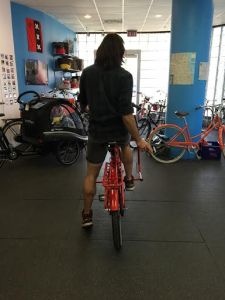
Photo source: Jon's phone
Sorry, bub. No elephant is going to see that weak-sauce turn signal when your calves are that chiseled.
1) SIGNAL YOUR TURN (aka be predictable)
So, let's say you're over here, and you want to go over there. First, look. Are there elephants around? Are they far enough away that you can make a maneuver? If yes, make sure the elephant sees you, then politely ask the elephant if you can make the maneuver in question. Elephants can't really talk or understand English (I think) so you have to use sign language. You're pretty small compared to elephants, too, so you have to make a BIG sign, none of this lazy elbow-tucked-in-one-finger-pointing-to-the-ground-immediately-to-your-left rubbish. An elephant is NOT going to see that. And they're also not going to see it if you only gesture for a moment. You need to be like one of those people at the end of the runway waving around the shining orange, short lightsabers.
You have to be really emphatic with that arm. Stick that thing out there. Make your hand annoyingly, stupidly flat and straight like a kid who thinks he knows karate but doesn't. It is a gesture that really, with a few different angles could, could be confused for a weird salute in one of the dystopian parallel universe episodes of Star Trek. But that's the least of your problems. If the elephant is wondering if it's a weird salute, you have won half the battle, because the elephant sees you and has seen your gesture.
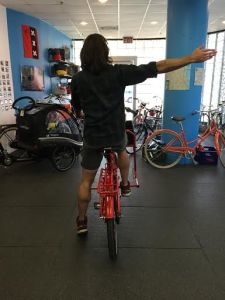
Photo source: Jon's phone
Now you're talking! Imagine you're backhanding an invisible pursuer in the face.
The second half of the battle is whether the elephant recognizes it's not a salute but sign language that's asking "can I go over there?" A great way to make this happen is to look again (this is a Double Whammy because you're checking your blind spot as you do this, too) and when your head is turned you can make eye contact with the elephant (they have such wisdom in their eyes) and see if they understand what you're asking and are giving you the space to go. If they slow a little or back off, or their speed is such that you can go, now and only now, is the time to go. That is both good etiquette, and it'll keep you safe around elephants.
2) GIVE VERBAL WARNING BEFORE OVERTAKING SOMEONE
A good chunk of bike etiquette and safety are really very interlinked. There's a reason these proper behaviors have developed; they keep you safe. Being safe on a bike isn't just being safe from elephants, but from other tarsier-things and from pedestrians, who we'll compare to, like Japanese beetles or something, I don't know, think of a smaller animal than a tarsier and slower. As with elephants, it all comes down to effective communication. Are you going to pass another bicyclist? Let them know. Bicyclists in the U.S. mostly understand English so you don't have to use sign language like with the elephants. You could say, "I'm coming up on your left," or just "On your left," or even, "Excuse me, do you mind if I pass you on your left?" if you're really Midwestern. Who knows? Maybe they do mind? Maybe they have levophobia (fear of objects to the left)?
It's also important to know when is a good time to pass someone. I would mind if someone passed me in the middle of an intersection. I don't know if this is an actual rule but it seems to freak people out. There's already a narrow amount of space bicycles are forced into on roads, and in an intersection you're squeezing between a bicyclist on one side and elephants on the other in the most accident prone facility of the entire transportation network. Just wait to pass a person until you're out of the intersection and there's some space to use.
The rule about giving a verbal warning before passing also goes for pedestrians on the bike path. I know, I know, everyone has headphones in, but just do it! And mean it!
3) USE LIGHTS AT NIGHT
Having lights on your bike at night is good etiquette (and in most places, it's the law, too) and it has probably saved more lives than helmets. I don't have any facts for that, because you can't really test accidents that flat-out didn't happen or were avoided because of lights, but I just have a hunch. Lights are like a visual way to communicate, "Don't worry! I'm here!" when it's dark out. It's so reassuring to see a little white light coming toward you on the bike path. Or, if you're riding an elephant, it's nice to see a red light hovering just to your right, letting you know that a bike (tarsier) is there. If you're not convinced on the importance of lights, there's a great video by Jason Jenkins of Active Transportation Alliance that will certainly sway you to the light side of the Force (get it? Light? Dark? We're talking about lights?).
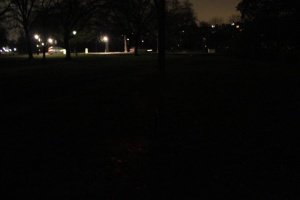
Source: http://www.londoncyclist.co.uk/knog-bike-lights-review/
Figure 1: Hmmm. Just a dark street.
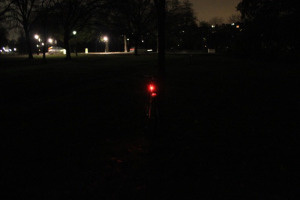
Source: http://www.londoncyclist.co.uk/knog-bike-lights-review/
Figure 2: Oh look! There's some sort of illuminated mystical creature there! Oh, nope. It's just a bike.
4) COMMON DANGEROUS SCENARIOS
There are some scenarios that develop very frequently on the roads, and knowing about them will help you. I have included visual aids with each one, too.
The Right Hook
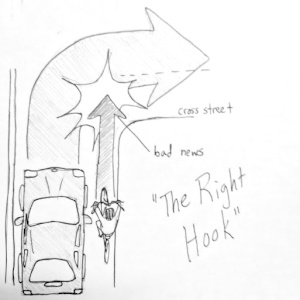
Source: Keith's Pencil
The Right Hook: a pretty self-explanatory bad situation
Okay, this one is so darn common it actually has a name. Basically, you're riding along, minding your own business, when a car pulls up next to you and then makes a right, maybe to park, maybe to turn, doesn't matter; the point is that you are directly to the car's right, and that's a bad place to be.
So what's the advice? You should put yourself in a place where you can a) see a turn signal or b) don't need to see a turn signal to know the car is turning (and be safely out of its way). This can be hard to do when a car is directly next to you. I'd say it's a good idea to be either a little behind or a little ahead of cars generally. Just find the area of the road where you have the most space around you possible, like a little bubble of air. If you're behind them just enough, you can see the turn happening and slow down to let them go in front of you. If you're ahead, they are likely going to decelerate into the turn, and you've avoided a collision simply by not being in the way.
Getting "Doored"
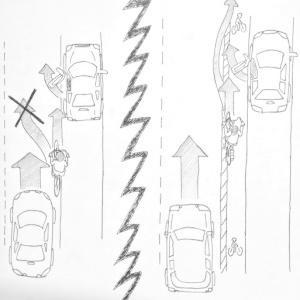
Figure 1 Figure 2
In Figure 1 the swerve puts you in the path of the car behind you. Better to just not ride so fast and hit the brakes, maybe have a chat with the person opening the door (don't be angry though, the last thing you need is road rage). In Figure 2 the swerve is less dramatic or nonexistent because the rider is using the left-most area of the bike lane.
Getting doored sounds like what it is: getting hit with a door. You're just riding along, minding your own business, when one of the cars parked to your right unexpectedly opens a driver's side door into you. This is a scary one because some streets have on-street parking that is completely full up the block, making every parked car seem dangerous.
The solution? Don't ride so fast. You'll need to do a little test on your own to see what your optimum city speed is. You shouldn't go so fast that if an obstacle (door, pedestrian, basketball, etc) came into your path you couldn't stop yourself in time, even if it was ten feet away.
The secondary danger with doors is that you may instinctively swerve to avoid the door. That swerve may bring you into the path of a car, which is why you should always opt to stop to avoid the door rather than swerve to avoid it.
As shown in the second Door Diagram, I would advise riding just far enough away from parked cars (near the left margin of the bike lane, if there is a marked bike lane) so that even if they did open a door, you'd either be already well clear of the doorswing, or far enough that only a small adjustment would steer you out of harm's way. Take note of whether a car just pulled in to park. In those cases you know for a fact there's someone in the driver's seat, likely anxious to exit.
The Left Hook
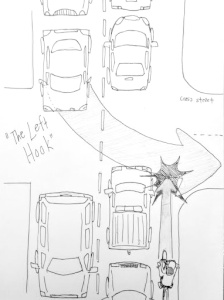
Source: Keith's pencil
Both the rider's and the left-turning motorist's line of sight is blocked by parked/moving cars on the street.
Like it's Right-handed cousin, the Left Hook involves a turning car striking you. In this case, though, the car is coming from the opposite direction as you and is making to turn left onto a cross-street. This can be even more dangerous when there's dense traffic, either moving swiftly or at a bumper-to-bumper standstill. The reason for the added danger is visibility. With so many cars around, it can be difficult for motorists (elephants) to see a tiny little bicycler (tarsier). What might look like a gap in traffic to the left-turning motorist might actually be a bicycler.
The way to prevent the Left Hook, once again, is to not ride so fast. This one is so common at rush hour that I almost expect a car to be turning left at every cross-street I reach. Just know that it's a distinct possibility everywhere you go and you'll be prepared to hit those brakes if you have to. Also, it's great to ride a bike that puts you in a very upright position (like a Dutch-style bike... hint hint). You'll sit up higher, can be seen over cars, and command more attention this way, not to mention you'll be able to see over cars, too.
And now for a few closing thoughts. I bet some of you are thinking, "man, what a drag. There are alllll these rules to biking, it makes me never want to bike in the city." Well, think about all the rules of walking that you already learned. To look both ways before crossing the street, to cross at crosswalks, to put your right foot forward, then your left, then your right, etc. You did that no problem but now you're whining about all this? Come on. Secondly, motorists have to go to this thing called Driver's Ed which is just mercilessly dull. Then they have to take a test and pass it and then a driving test and then pass that. Whereas from the age of five you can basically go anywhere in a city by bike, park for free, and not get taxed. It's pretty great.
On the other hand, I do wish bicyclists had to go through some kind of education, too. In fact, I think that everyone should go to something called "Traffic School" and that they learn about biking, bussing, carring, training, walking, roller blading, and skateboarding. I think that would at least ensure that motorists have a decent idea of what it is like to ride in traffic with cars, and that bicyclists behaved civilly, too, so that all of Motordom doesn't get collectively ticked off by bicyclists. When I think about it, I myself had to pass a test of sorts in order to bike on the street, it was administered by the director of the Parental Bicycling Administration. And now I'm passing on that knowledge to you. I guess I'm just turning into my dad.

Comments
Be the first to comment...